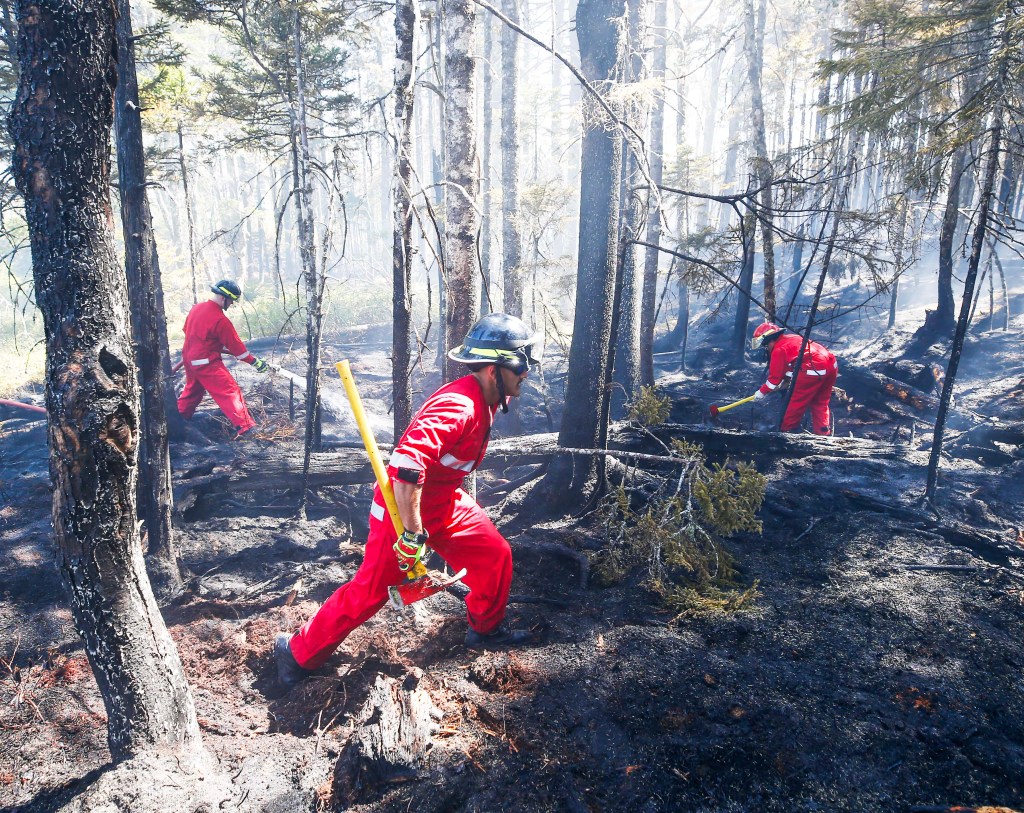
I have come to think of it as the Betsy Boomerang — that moment when something you didn’t know, had forgotten, ignored, dismissed, avoided or pretended wasn’t something… suddenly becomes a thing that you desperately need to understand and can no longer forget, ignore, dismiss, avoid or pretend wasn’t anything.
Until that moment passes too, and we’re back where we began.
We’ve experienced a few too many Betsy Boomerang moments in the last few years.
The lack of a proper provincial emergency alert system when we so desperately needed it during the 2020 mass shooting, for example, and, more recently, the climate-changing, wildfire-at-the-doorstep discovery of just how many local subdivisions had been built with only one potential deadly gridlock-producing way in and out.
But let me start with Betsy Chambers.
Back in the day, which is to say the 1980s and ’90s in Nova Scotia, Chambers was a little-known but quietly determined independent journalist.
During the fall of 1991, she covered the Nova Scotia legislature for Thomson Newspapers, an unambitious national chain of mostly small-town publications whose Nova Scotia properties included the Cape Breton Post and the New Glasgow Evening News.
Because those were coal mining communities — on September 11, 1991, the New Glasgow paper, in fact, had grandly celebrated the grand opening of the community’s new Westray mine as manna from government-funded heaven — any mention of coal was news its editors would notice.
So, when Bernie Boudreau, then a Liberal opposition MLA, stood up in the House of Assembly to report that some Westray miners had become so concerned about mine safety a few had even “voted with their feet and quit,” Chambers knew it was a story.
An overworked legislature reporter’s easy response would have been to toss off a few-paragraph brief quoting Boudreau, then move on to the next story and the one after that. Reporting on a legislative session can sometimes seem like working on the assembly line in a busy factory. Besides, the Thomson chain wasn’t known for rewarding reporters who displayed initiative.
But Chambers did just that. On October 23, 1991, the Evening News published Chambers’ in-depth interview with an experienced hard-rock miner who’d quit after just four days at Westray. “Some things are more important than money,” he told her ominously.
Chambers followed up with the department of labour, which blithely dismissed the miner’s concerns about coal dust. (In fact, although they published her story, the editors of the Evening News were hometown-quick to defend the company’s “safety precautions” in an editorial contradicting Chambers reporting.)
Despite that, Chambers refused to back off. The next day, she served up yet another exposé. The son of the labour department’s supposedly independent safety inspector had been quietly hired by the mine’s owners. Of course everyone involved — the labour minister, the company spokesperson — dismissed the notion that this hiring represented a blatant conflict of interest and the likelihood the department’s inspections may have been less than rigorous as a result.
After that, Chambers’ story died. No one else followed up. Until it was too late.
On May 9, 1992, a massive methane gas explosion rocketed through the coal-dust-laden innards of the Southwest 2 tunnel of the Westray mine, trapping and murdering a full shift of 26 miners.
In the aftermath of the tragedy, I was far from the only journalist who tracked down faded clippings of Betsy Chambers’ reporting and wondered at the enormity of what we’d failed to report. A Betsy Boomerang moment.
I couldn’t help but think about that again last month as I watched the story behind the story of the wildfires in Tantallon emerge. The issue, quite simply: too many people in too many subdivisions with too few ways in and out.
Although there were — miraculously — no deaths or injuries reported during May 28’s sudden, unplanned evacuation of a number of subdivisions off the Hammonds Plains Road near Tantallon, that had more in common with good luck than good planning. The possibility/probability of tragedy as 16,500 residents fled for their lives was omnipresent.
As Pamela Lovelace, the councillor representing the district, told city council last week, area residents “have been looking for egress for decades…
Over the last four or five decades, subdivisions have been built off of Hammonds Plains Road. I call them balloons because they all direct traffic into Hammonds Plains Road and they’re not connected to one another.
That’s problematic when situations like a wildfire come up. Or issues around even just having a single structure on fire and then people can’t get out, they can’t get in.
For more than five years, she said, the residents of the Westwood Hills subdivision had been in talks with municipal staff “on finding a back exit for this subdivision.” Lovelace herself had moved a motion in early 2021 calling for a staff report on “budgeting and creating community connector roads.” That motion passed, but the report it called for isn’t expected until later this year. At the time, news of the motion generated barely a ripple.
And then, without immediate warning but far too much long-term warning, the fires flared out of control. On Tuesday, June 6 — nine days after the fires began — councillors unanimously approved Lovelace’s motion for a staff report on developing a secondary exit out of the Westwood Hills subdivision.
The day before that, the city had invoked its local state of emergency powers to begin building two permanent gravel-gated exits on municipal lands so residents of Haliburton Hills and Highland Park subdivisions could escape if necessary.
But the reality, as other councillors pointed out, is that those Tantallon area subdivisions are far from the only ones with access issues.
“There’s nothing new about this situation,” noted the Examiner’s Tim Bousquet wearily.
Bureaucrats at both the municipality and the province have known about the risks for many years, and yet no action was taken to improve emergency exits or to improve the infrastructure needed for fighting fires — there is a dearth of both fire breaks and hydrants throughout the area.
Will this finally be the canary-in-the-coal-mine moment when we demand — and force — changes, or will we get bored, turn away, again, and wait for a larger human tragedy before we act?
Our track record is not hopeful.
Despite the deaths at Westray, it took more than 20 years and a relentlessly determined effort led by the United Steelworkers and the late NDP leader Alexa McDonough to finally convince parliament to pass what became known as the Westray bill to make those who “direct the work of others” legally and criminally responsible for ensuring their safety.
While the legislation did help change attitudes toward worker safety, there is continuing debate over its effectiveness, and many argue the law needs to be enforced more forcefully.
And then, consider the province’s emergency alert system. It failed us badly in the Portapique mass shooting in April 2020, largely because the RCMP failed to use it until it was too late.
Now, officials have become so enamoured with the “emergency” alert system, they even used it during the recent wildfires to let people know when it was safe to go home. On a couple of occasions, Mayor Mike Savage even telegraphed news an “emergency alert” was about to be broadcast, a non-emergency notice that some evacuated residents could now return home.
As Bousquet pointed out in Morning File,
Telling people in advance that there will be non-emergency “emergency alerts” today is really rotten policy! It means people will ignore the alerts, because they’ll think “oh, it’s just a recision of an evacuation order.”
Additionally, once the alert system gets watered down with warnings about things that aren’t imminent threats to life, I worry about “alert creep” — such that the public is warned about ever lesser threats to life until we get to the point of alerts about shoplifters and lost dogs.
The better-than-worst news — if we can describe it as such — is that our previously ignored alert system is finally operational. We can fix its faults. Just as we can push for more prosecutions under the Westray law because there is such a law. And now that the wildfires have grabbed our attention, we can resolve to insist municipal and provincial governments do something sooner rather than later.
We can. But will we? Or is this just one more Betsy Boomerang moment we’ll look back on and ask ourselves why we didn’t?
***
A version of this column originally appeared in the Halifax Examiner.
To read the latest column, please subscribe.







 STEPHEN KIMBER, a Professor of Journalism at the University of King's College in Halifax and co-founder of its MFA in Creative Nonfiction Program, is an award-winning writer, editor and broadcaster. He is the author of two novels and eight non-fiction books. Buy his books
STEPHEN KIMBER, a Professor of Journalism at the University of King's College in Halifax and co-founder of its MFA in Creative Nonfiction Program, is an award-winning writer, editor and broadcaster. He is the author of two novels and eight non-fiction books. Buy his books